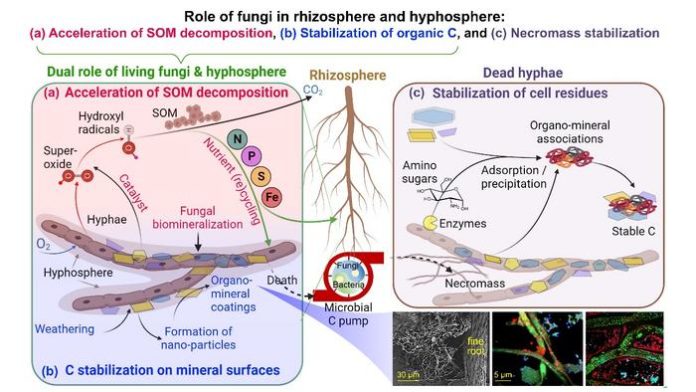In a groundbreaking study published in Science China Earth Sciences, researchers have uncovered evidence that fungal networks play a far more crucial role in long-term carbon storage than previously understood, potentially offering new insights into managing climate change.
The research, led by Dr. Guanghui Yu from Tianjin University’s School of Earth System Science, reveals that fungi create intricate underground networks that not only connect plant communities but also serve as natural carbon vaults, storing carbon for millennia in stable forms within soil.
“Most vascular plants form mycorrhizae, where fungi exchange carbon for nutrients like phosphorus and nitrogen,” explains Yu, describing the symbiotic relationship between plants and fungi that forms the foundation of this carbon storage system.
The study’s findings challenge traditional views of soil carbon storage by highlighting the unique role of fungal biomass across six different ecosystems. When examining topsoil samples, researchers discovered that fungal networks account for a staggering 86% of the total microbial biomass carbon, demonstrating their dominance in soil carbon dynamics.
Using cutting-edge nanoscale imaging technology, the research team observed something remarkable in pine tree root systems: fungal threads (hyphae) were encased in a protective mineral shield approximately 500-600 nanometers thick. This mineral coating acts like a natural preservation system, helping to lock away carbon in stable forms that can persist for thousands of years.
The implications of this discovery extend far beyond academic interest. As the world grapples with rising carbon dioxide levels, understanding natural carbon storage mechanisms becomes increasingly critical. These fungal networks essentially operate as nature’s own carbon capture and storage system, working silently beneath our feet across forests, grasslands, and other ecosystems.
The research team employed high-resolution nanoscale secondary ion mass spectrometry to study these fungal-mineral interactions in unprecedented detail. Their analysis revealed that fungi contribute to carbon storage through multiple mechanisms, including the production of reactive oxygen species that aid in organic matter decomposition and the formation of stable organo-mineral complexes.
What makes this study particularly significant is its comprehensive approach, examining fungal impacts across diverse ecosystems while also diving deep into the microscopic mechanisms at play. The research shows that fungal networks extend far beyond the immediate vicinity of plant roots, creating what scientists term the “hyphosphere” – a zone of influence that surpasses the traditional root zone in both size and ecological impact.
The study also sheds light on what happens when these fungal networks die. Rather than simply decomposing, the dead fungal material, or “necromass,” continues to play a vital role in carbon storage. These remnants interact with soil minerals to form stable compounds that can sequester carbon for extended periods.
This research comes at a crucial time as scientists and policymakers search for effective strategies to address climate change. Understanding how fungi naturally sequester carbon could inform land management practices and conservation strategies aimed at maximizing natural carbon storage capacity.
Looking ahead, these findings could influence how we approach forest management, agriculture, and ecosystem restoration. By better understanding the role of fungal networks in carbon storage, we may be able to enhance natural carbon sequestration processes as part of broader climate change mitigation strategies.
The research represents a significant step forward in our understanding of natural carbon cycling and storage mechanisms. As climate change continues to pose challenges, the humble fungal networks beneath our feet may prove to be unexpected allies in the quest to reduce atmospheric carbon dioxide levels.
If you found this piece useful, please consider supporting our work with a small, one-time or monthly donation. Your contribution enables us to continue bringing you accurate, thought-provoking science and medical news that you can trust. Independent reporting takes time, effort, and resources, and your support makes it possible for us to keep exploring the stories that matter to you. Together, we can ensure that important discoveries and developments reach the people who need them most.




